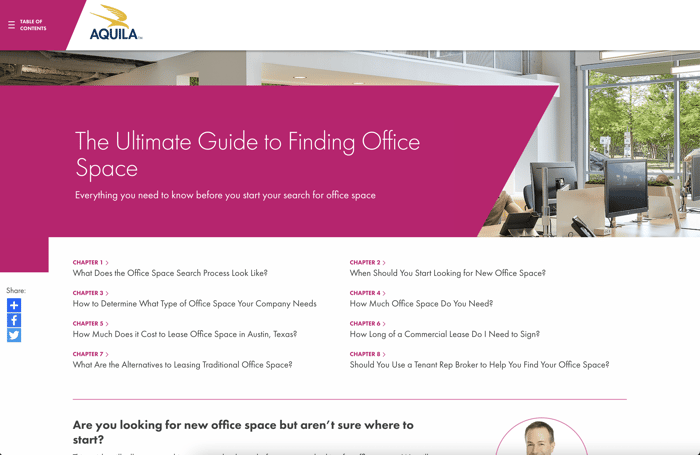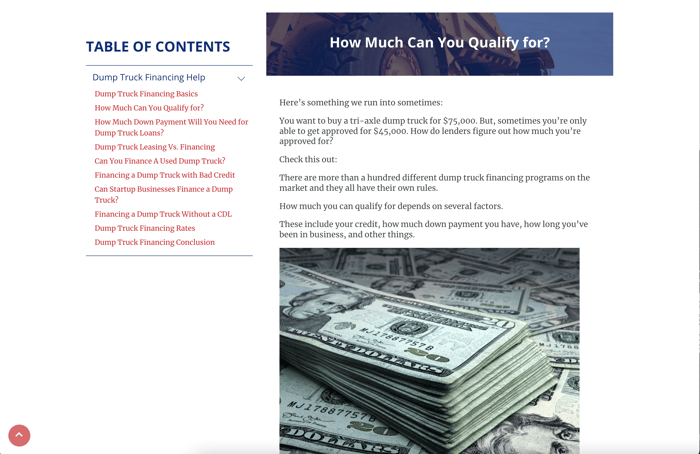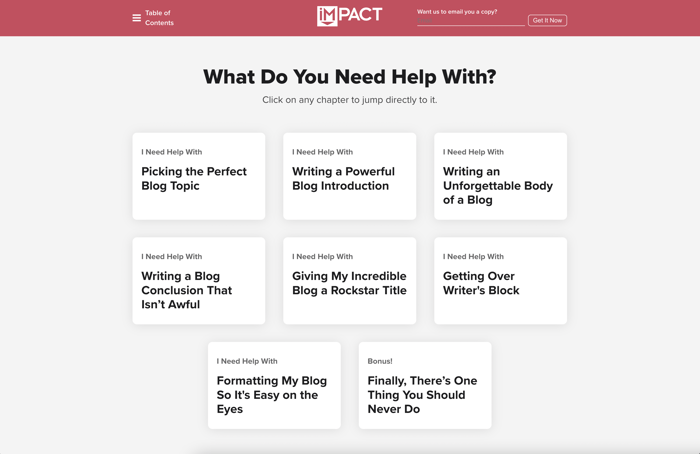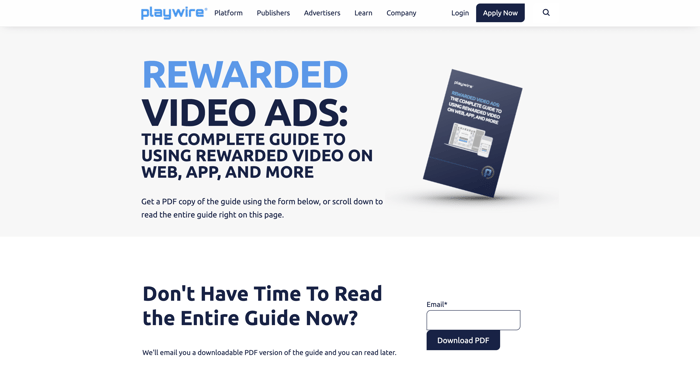The last SEO content strategy guide you’ll ever need
If you’re a growth-motivated marketer or business owner who wants to drive more traffic and qualified leads to your website, so you can close more deals faster, you’ve come to the right place.
WANT TO READ THIS UNGATED GUIDE LATER? TAKE THE PDF WITH YOU!
Part I. What is an SEO content strategy?
Before we can answer that question, we need to answer another question first. How do you know if your SEO content strategy is working?
If you answered, “Our site traffic goes up!” you’re mostly correct. The real secret to a successful SEO content strategy is that it should only bring you more of the right eyeballs to your website – specifically, it should lead your ideal customers to your content at the exact right time.
After that, you’ll be able to convert them, nurture them, and then (fingers crossed) transform them into a buyer – and then it’s customer delight time, folks.
If this is what you’re trying to achieve for your organization through content, you need to beware of most of the piss-poor “definitions” of SEO content strategy that exist out there. What I mean by that is, the last thing you want to do is listen to anyone who tells you that an SEO content strategy is achieved through a single tactic or done with ease overnight.
🔥 Register now: SEO content strategy masterclass (limited seats)
If anyone tells you that, while also making tempting promises of landing on “the front page of Google,” they’re lying to you.
So, what is the real definition of an SEO content strategy?
A successful SEO content strategy that attracts and converts qualified buyers will leverage a blend of strategic activities including knowing what content to create based on your business goals and keyword research, taking that content and optimizing it for search engines effectively, and not undermining your website ranking potential by keeping your technical SEO house in order.
Now, it doesn’t matter if you’re new to content entirely or your company has been creating content for some time – checking off each of those SEO content strategy boxes can feel like quite a mountain to climb:
- If you’re new to content, you’re often overwhelmed by bad advice and misinformation, when all you really need is a clear playbook to help you get started with your SEO content strategy.
- If you’re not new to content, it’s not uncommon to look back and see that you’ve somehow managed to create 536 pieces of content without actually hitting your traffic, leads, or sales goals with any degree of consistency. And that can be pretty freakin’ demoralizing.
If either of those scenarios sounds familiar, I want you to take a deep breath and relax. You are not the first or the last person who will be in your position, so you’re certainly not alone …. and that’s exactly why I created this SEO content strategy guide.
We’re going to make SEO content strategy easy for you
I’ve spent more than a decade working with thousands (yes, thousands!) of marketing professionals and business owners to teach them how to use content to bring more of the right people to their virtual doorstep, so they can achieve their growth goals. And you deserve to see the same level of success that they do.
🎙️ HubHeroes Podcast: What is content strategy? (2023 and beyond)
So, strap in, everybody! Please make sure your arms and legs are inside the SEO content strategy vehicle at all times and that your tray tables are in the upright position as we prepare for takeoff.
Even if you don’t use HubSpot for your marketing, sales, or service automation, you’re still golden. By the end of this guide, you’ll not only understand what an SEO content strategy is, you’ll have a playbook in your hands that will enable you to immediately jumpstart your organization’s strategic content efforts.
Not only that, you’ll be saying to yourself, “Wow, this isn’t as scary or as hard as I thought it was going to be!”
Part II. How search engines like Google rank content
The first building block of your SEO content strategy that we’re going to talk about is creating the right content. Yes, great content strategies will support your entire funnel – not only attracting new leads, but also enabling sales during the closing process.
But developing the content you need to increase website traffic means you are focusing solely on the ATTRACT phase of the process:
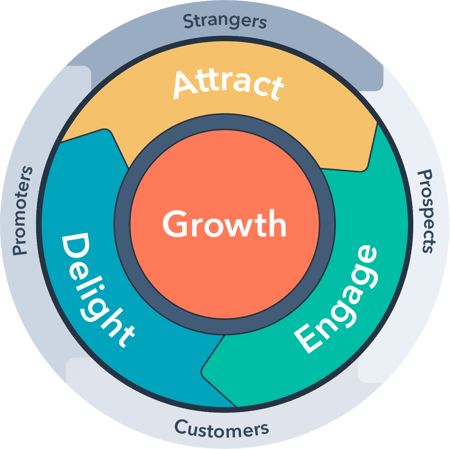
Image credit: HubSpot
Ten years ago, figuring out what to write was a bit more of a straightforward process. With a little research and mental elbow grease, you’d come up with a big list of keywords – maybe even hundreds of ‘em – and get to writing in whatever order made the most sense to you.
Heck, you might have even found yourself writing the same article a few times (with slight variations), because there were so many different (yet similar) keywords you wanted to rank for.
This approach does not work anymore.
What’s changed in how Google ranks your website content
As creating content has become more mainstream as a strategy for companies looking to grow, search engines like Google made their algorithms more advanced and sophisticated.
Like you, Google also has customers – everyone who fires up the Google search engine. So, out of necessity, Google has worked tirelessly to change things up with their ranking algorithms to guarantee their customers (which likely includes you) are always served the most relevant and high-quality content that matches exactly what they are looking for.
At the very same time, we humans have become pickier and more demanding about the search results we get from Google.
For example, think about how many times in recent years you’ve searched for something online with the term “near me” included. Even though you’re not telling Google where you are, you expect that Google will be able to figure that out and give you the results you’re looking for, right?
To meet this demand for more relevant content, faster (and with less explicit context), Google has designed its algorithm to be more interested and approving of sites that not only publish high-quality content in a way that’s user-friendly but also do so in a way that makes it easy for the search engine to understand what the heck your website is about.
The folks at HubSpot even created a handy timeline that reviews some of the biggest updates of the past few years:
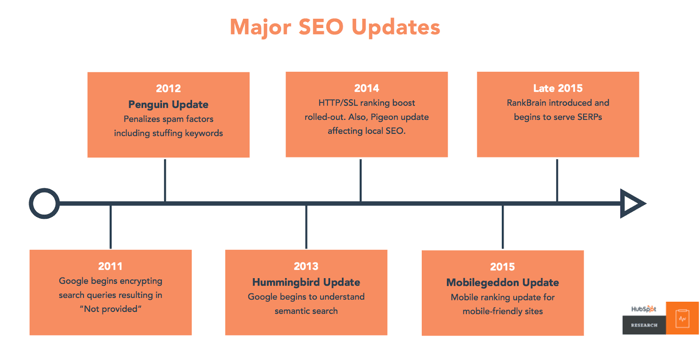
Image credit: HubSpot
Although even recently (summer 2022), Google has made waves with their Helpful Content Update which outlines explicitly how brands will be rewarded for creating unique, relevant, expertise-laden content … and, more importantly, how they will be actively penalized with diminished rankings if they don’t.
🔥 HubHeroes Podcast: What makes great content GREAT?
That means today if you’re writing up a bunch of hundreds of disorganized blog articles where it’s hard to tell how everything is connected or what big categories you’re trying to own as your areas of expertise, Google will not send you the website traffic you want.
How you need to structure your content strategy today
If we’re all tossing out our endless spreadsheets of disorganized target keywords for blogs, then what the heck are we supposed to put in its place? How can you signal to Google through the content you create what areas of expertise you possess, so they know to tee you up any time one of your ideal buyers comes a-knockin' for the undeniable industry know-how you possess?
By creating interconnected networks of related content that make it easy for Google, Bing, and others to understand what your website is about.
What I mean by that is:
- What industry you’re in (the expertise)
- Who your ideal target audience is (the searcher)
- How you help them (the substance)
The building blocks for this type of SEO content strategy architecture are called topic clusters and pillar pages. And if you’re wondering what the heck those are, I’ve got good news for you – we’re going to dig into what those mean in the next couple of chapters.
Part III. Topic clusters and pillar pages (a crash course)
Now, some of you may be familiar with these terms. Others of you may not be. Either way, I want to make sure we’re starting this conversation with a shared understanding of what these terms mean, since there can be some confusion.
This is confusion we can't afford, because topic clusters and pillar pages are the beating heart of how you organize the traffic-driving content for your SEO content strategy.
What is a topic cluster?
A topic cluster in a content strategy is a network of connected content pieces (blogs, videos, podcasts, etc.) that all relate to the same central topic.
🔎 Related: What is a topic cluster? (definition + examples)
Here's a video for you visual learners out there that is a crash course in topic clusters:
For example, let’s say someone like me is your ideal customer … you might want to own the topic HOODIES FOR MEN and create a topic cluster around that topic. If so, it would look something like this: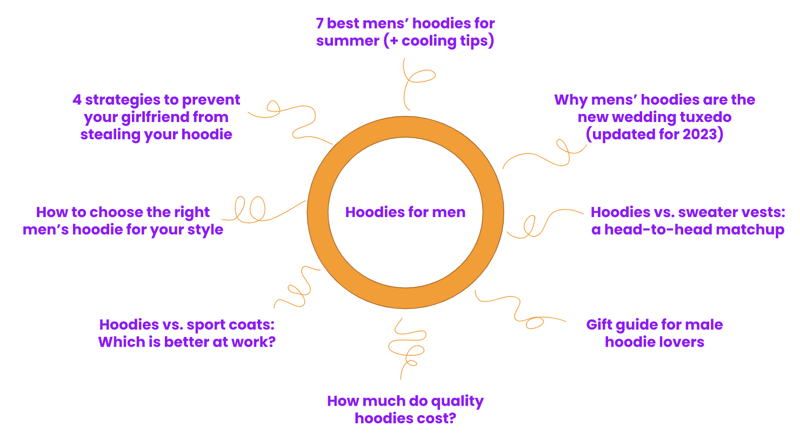
Topic cluster example of my dreams
The center of your topic cluster – HOODIES FOR MEN – is the hub around which all of the other hoodies-related content (called SUBTOPICS) revolve.
How to choose the right topic clusters for your SEO content strategy
The key to your SEO content strategy, of course, is choosing the right topic clusters for your organization. Because just like the scientists who brought back the dinosaurs in Jurassic Park, just because you can make a topic cluster about something doesn’t mean you should.
That means you’ll want to choose topic cluster topics – validated with keyword research using tools like Semrush or Answer the Public – that relate directly to the products or services you sell. For example, if you are a technical recruiter, “technical recruiting” would be a great candidate for a topic cluster subject.
🎙️ HubHeroes Podcast: Topic cluster strategy crash course
The key to picking a great keyword for your topic cluster subject is to keep it big and broad, with a meaty amount of website traffic to back it up. This is different from how you’d go about selecting a keyword for a blog topic.
Here, let's look at two examples:
- Website redesign is an ideal topic cluster keyword – it’s broad with lots of website traffic.
- HubSpot vs. WordPress is much more specific, making it an ideal keyword for a subtopic in your website redesign topic cluster.
What do I mean by “lots of website traffic” for a topic cluster keyword?
Well, it depends. You don’t want to go after keywords that have hundreds of thousands of searches per month – those are too broad, to the point where it’s hard to tell who’s searching for it and why; more than that, they tend to be highly competitive, which will make it hard for you to rank.
For instance, as much as I am a man who loves a quality hoodie, we actually wouldn’t want to write that topic cluster:
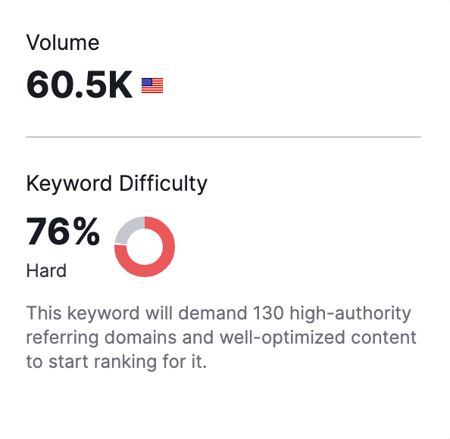
According to the screenshot above of data ye ole Semrush, the high volume and the steep degree of difficulty would make it a less than ideal choice for me. In a perfect world, the keyword you choose (if you have access to this kind of data through a more robust tool like Semrush), you’re looking for approximately 50% or less in keyword difficulty.
On top of that “lots of traffic” is a relative phrase.
Depending on how niche your industry is, the “big broad” keywords will only have hundreds of searches per month, rather than thousands; and your supporting subtopics in that case may have tens of searches per month, rather than hundreds. This is common in a lot of highly regulated industries, B2G, companies with a regional or local footprint, and so on.
“George, my head is spinning, this is a lot to take in!”
I know, it can feel overwhelming at first. Just remember to always bring it back to the humans you serve, and you’ll be just fine:
- What do YOU, as humans, do or sell?
- Based on that, what online conversations do you need to own?
- What do the humans you serve want to know about those topics?
Then, let the data take you from there.
How to prioritize topic clusters in your strategy
Now, depending on what you do, there is a high degree of likelihood that you’ll have quite a few options for topic clusters. So, how do you know which one you should work on first, and how do you determine the order for the rest?
🔥 Related: 47(ish) essential content strategy scoping questions list
Again, instead of worrying about data or satisfying some magic content strategy formula, I want you to look at whatever list you have of topic clusters through the lens of your business:
- What parts of my business (related product or service lines) need the most help right now from a sales pipeline perspective?
- Are there any new product or service launches in the near future where one of these topic clusters can help us drive demand?
- What are the most important parts of our business where we must be the leading authority?
- What are the parts of our business that are super healthy and don’t need immediate help in driving demand or establishing authority?
Asking yourself these types of questions can be really powerful. Not only will your answers help you organize your battle plan for which topic clusters you create (and in what order), but it will also tell you if there are any topic clusters you shouldn’t be developing. Because, if you find you have topic clusters on your list that don’t somehow relate to your business, you shouldn’t be writing about them.
For example, let’s say you’re an inbound marketing agency, but you don’t do websites for your clients. You likely shouldn’t focus your efforts on creating content about the HubSpot CMS Hub for business websites or anything having to do with websites.
Sure, keyword research will show you lots of people who are your target audience are interested in those topics; but if you don’t support or design business websites, why would you want to be known for it?
What is a pillar page?
Content pillar, pillar content, pillar page – it doesn’t matter what you call it, each of these terms refers to the same thing:
A pillar page is the central content hub that serves as the definitive guide on the big broad topic you’ve built your topic cluster around. So, in the case of our hoodies for men example – sorry, I just can’t let it go! – your pillar page is a definitive guide to everything your ideal customers need to know about hoodies for men.
Or, if you want an even better example, you’re on a pillar page right now.
That’s right! This ultimate guide to SEO content strategy is a pillar page, my friends. And it's a perfect example of the three characteristics every single pillar page must possess:
- The substance of your pillar page should be so dang good and comprehensive, it becomes the last search result your ideal customers will ever need on this topic. They should be saying, “Oh my gosh, finally! This is exactly what I’ve been looking for! I have achieved content nirvana!
- The storytelling on your pillar page is compelling, intuitive, and engaging – in short, it’s human. Because it doesn’t matter how much detail you put on your pillar page; if you don’t communicate information like a human through story and smart narrative structure, you’ll lose your audience.
- The visual structure and design of your pillar page doesn’t suck. I love pillar pages that keep me visually engaged and stimulated as I move through it. I’m not saying you have to suddenly go all out with design, but be purposeful in how you treat your headers and subheaders. Use images and graphics (only when relevant), bulleted lists, and more.
Easy, right?
Yeah, yeah, yeah, I know! It sounds like a lot. I can help with that.
Pillar page frequently asked questions (and other myths)
Now, in all fairness to you, pillar pages get kind of a bad wrap because of their size and perceived complexity. So, let’s clear the air on some of the most common FAQs and myths I’ve heard of.
Do our pillar pages have to be 10,000 to 15,000 words long?
No, they don’t. Word count maximums and minimums are entirely arbitrary, and that’s especially true in the pillar page world. Here’s what content strategist and pillar page expert Liz Murphy had to say about that:

“Ugh! I find this myth so infuriating because it makes people believe they have to write War & Peace in order to have a pillar page that’s worth anything, when that’s not true! I’ve written pillar pages that are 5,000 words long, and I’ve written pillar pages that are 12,000 words long – and they perform equally well.
My advice? Ignore your word count entirely! Just write until you’re done. Because if you write to the right depth in order to satisfy the needs of your audience – i.e., 'I’ve answered all the relevant questions my ideal customer would have about this topic in a way that won’t make them hate me, because all I did was create more questions!' – you’re going to knock it out of the park with whatever you create.”
Liz Murphy
Founder, Buona Volpe
Or, another way to think about it is forget the robots and the data, and focus exclusively on the humans you’re serving through your piece of content.
If you’re creating the most definitive guide on a topic, cover all of the FAQs you hear from prospects in discovery calls – ask your sales team if you don’t know! If you’re taking someone through a step-by-step process, show visuals and highlight examples that make it easier for them to understand the concept and immediately apply it.
Should my pillar page be the Wikipedia page for a topic?
I’ve seen pillar pages described this way and, I’ll be honest, I don’t love it. Wikipedia pages are designed to be the “kitchen sink” of a topic, with every tiny detail about a specific topic covered, from every conceivable angle.
Pillar pages, even though they are broad in scope, should be designed to solve a specific problem for a specific audience (or audience groups) in mind.
For instance, SEO content strategy could be written to anyone, but the most important and relevant audience groups to me are you – the content marketer who needs to create the content strategy and the business owner who is looking for a new way to bring more eyeballs to your website.
This is what will not only keep your word count under control, it will also keep the substance of what you write about laser-focused.
So, once you pick your topic, ask yourself these questions to develop your pillar page strategy:
- Who is searching for this topic?
- Why are they searching for this right now, at this moment?
- What questions are they trying to answer?
- Are there specific goals or challenges in front of them right now?
- If we know who they are and what they're looking for, what do we need to cover for them to feel satisfied by the end of it?
Then, your pillar page will pretty much write itself.
Tackling a pillar page is such a massive undertaking; do you have any advice on how to get it done?
I wish there were some fancy hacks I could share here, but creating your pillar page will take work. So, treat it like you would any other big project – break it down into bite-sized pieces. Yes, set a final deadline for the entire draft, but also set interim milestone goals. It’ll be a lot less stressful for you in the long run with that approach.
I would also recommend using free/freemium tools like Grammarly and Hemingway to help you with the scale of your editing process. Even the best writers will have an error (or five) show up when they’re writing something that’s over 5,000 words long.
Should my pillar page be gated?
Absolutely not. In fact, if you put your pillar guide behind a form (like with a traditional landing page), you don’t have a pillar page. You have an e-book. Your entire guide must be entirely accessible without someone having to fill something out in order to read it.
Now, you may have noticed that even this guide had a form at the top, so what gives? Pillar pages are organic traffic magnets, but they can also be powerful lead generation tools, as well.
🔎 Related: 4 pillar page strategy mistakes you can't afford to make
Think about it – a pillar page like this is massive in scale. The humans you’re creating your guide for are a lot like you, right? So, if something is super valuable, but also crazy long, they may want to read it later. Offering them the ability to download the PDF for their convenience makes a lot of sense.
Can I link to stuff on my pillar page that’s not on our website?
Heck yes! One of the ways in which Google evaluates whether or not a piece of content is of high quality is what sources you cite to “make your case” or tell whatever story it is that you’re telling.
So, I strongly encourage you to use data and statistics, when it makes sense. Be careful that the sources you cite, however, are highly reputable and not from the digital stone ages. Choose primary sources, whenever possible. Be mindful of the date of any statistics you’re pulling – e.g., if you’re citing research that is collected on an annual basis, don’t pull stats from 2016.
What should the title of our pillar page be?
You want a title that accomplishes three things:
- Communicates how awesomely definitive your guide is
- Makes it clear who the audience is for your guide
- Puts your SEO keyword front and center
To check all three of those boxes, I recommend a strong TITLE and SUBTITLE strategy that looks a little something like this:
Here’s another example:
And here’s another:
Again, make it clear to the humans (and the search engines) what it’s about with that strong title in an H1 tag. Then add context of who it’s for and what it’s about with a focused subtitle.
Pillar page examples
OK, we’ve talked a lot about the theory of pillar pages but, as I mentioned, they come in a wide variety of shapes and sizes. So, let’s walk through some examples of real-world pillar pages to take your learning on this topic to the next level.
The Ultimate Guide to Finding Office Space
Aquila Commercial
This pillar page example from Aquila Commercial checks all the boxes. It's built for humans with a clear and intuitive user experience, audience-focused narrative structure, and easy navigation. It also addresses a clear problem for a specific audience, framing the entire table of contents through the lens of the most commonly asked questions about the topic.
Dump Truck Financing, the Complete Guide
Smarter Finance USA
This pillar page example from client Smarter Finance USA shows that you don't need to have a graphic design background to make an ultimate guide experience for your audience effective, easy on the eyes, and genuinely helpful. Sometimes the most powerful content experiences are like this one from Smarter Finance USA – it's a clean showcase of clear expertise that doesn't confuse the audience with completely unnecessary visual bells and whistles.
Definitive Blogging Tips Guide for Content Marketers
IMPACT
This pillar page example is an oldie, but a goodie from Liz Murphy, back when she was the editor-in-chief at IMPACT. There are a few things I like about this one. She was able to streamline the title in such a way where the keyword "blogging tips" is still the lead in the H1, but it also includes a qualifier of "content marketers," so it's clear who the audience is.
On top of that, the table of contents (shown above) is more "Choose your own adventure!"-style in how they're labeled – "I need help with..." vs. "Chapter X" – so people are encouraged to jump to where they need the most help.
Rewarded Video Ads: the Complete Guide
Playwire
This pillar page example is a masterclass in how businesses in complex industries can establish thought leadership in a powerful way. Playwire is a digital advertising platform for publishers, and this pillar guide really knocks it out of the park in a number of ways.
🔥 Related: A content strategist's case for the HubSpot CMS Hub
First, the topic, while complex, is presented in a clean and digestible way. Second, the design, although minimalist, features engaging pops throughout in the form of videos, animated graphics that illustrate concepts, and more. Finally, it's pure selfless education on display. Yes, it's a lead generator, but it focuses on the needs of the audience first – that's the real value.
The right way to do linking in your topic clusters
This is probably one of the top mistakes well-meaning content marketers and teams make with topic clusters and pillar pages. It’s also the one mistake that, if you make it, all of your hard work writing thousands of words for a pillar page will be for nothing – so we’re dedicating an entire section to the topic.
Let’s look at our topic cluster example one more time:
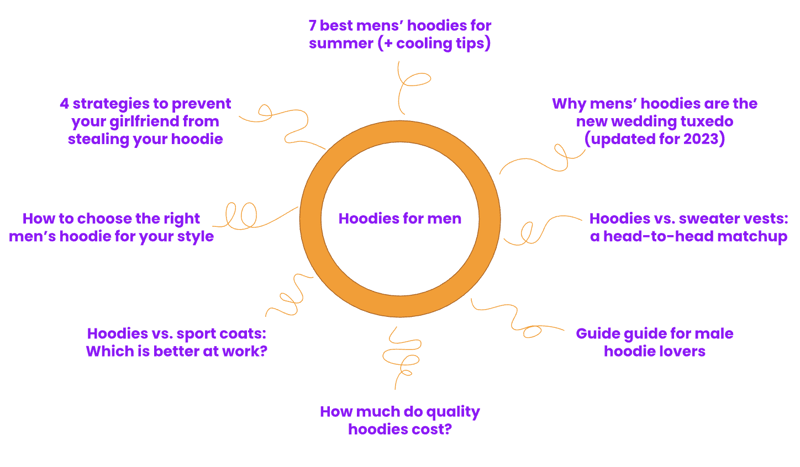
As a quick refresher, the idea behind a topic cluster is that you demonstrate to Google and other search engines that you’re a HOODIES FOR MEN authority because you have this giant network of content about the topic all linked to each other.
And that right there is the key – “all linked to each other.” In order for your topic cluster to function properly and drive the organic web traffic you’re looking for:
- Your pillar must link out to every single subtopic in the cluster.
- Every single topic must also link back to the pillar.
Usually, the mistake I see folks make is they’ve only checked one of these boxes. They either only have the pillar linking out or they only have the subtopic articles linking back to the pillar. Your linking must be done in both directions.
Diversify the types of content for your subtopics
Did you know that a subtopic in your topic cluster doesn’t have to always be a blog post? That’s right! You can pull podcasts, videos, checklists, webinars, and other unique types of content into your topic cluster.
This actually will make for a highly dynamic, visually exciting, and human experience on your pillar page. Imagine scrolling through a pillar page to find links to relevant videos, checklists that help you immediately implement a piece of what you’re learning, or a webinar with an expert that helps you explore a concept more deeply.
When putting together your topic cluster, I encourage you to think beyond the tried-and-true blog article. Yes, definitely have a few of those, but aim for a holistic mix of content types. It’ll not only be more fun for you to create, you’ll also do a better job of meeting the needs of your ideal audience in an educational and actionable way.
Learn moreAdd a headline.
Lorem ipsum dolor amet food truck affogato cronut freegan skateboard photo booth, tousled pickled 90's wayfarers retro succulents hoodie edison bulb ramps. XOXO seitan tote bag, offal vape air plant disrupt chia plaid taxidermy cloud bread microdosing 8-bit.
Part IV. On-page SEO for your content strategy
OK, going back to our definition of what a successful SEO content strategy really is, it's not a single tactic, right? It’s a blend of activities – creating the right content, optimizing that content well for search, and then guaranteeing your website isn’t accidentally knee-capping your ranking potential.
We talked about creating the right content in the last section with topic clusters and pillar pages. Now, we’re going to talk about how to optimize your content for search engines through on-page SEO.
Before we dig into my favorite on-page SEO best practices, I do want to clarify one thing that’s important for you to always remember.
When you pull up data in a platform like Semrush, it can be all too easy to forget there are humans behind all of these numbers.
There’s a saying in marketing: “Write for people first, optimize for the robots second.”
I understand what this quote is trying to encourage, but it’s misleading. At all ends of the spectrum, you’re creating helpful content for humans that solves problems on their terms. Even when you get to this stage where you’re “optimizing for the robots,” you’re still really only optimizing for the humans.
So, as we walk through some of these best practices, remember that you’re actually not trying to make search engine robots happy. All you’re actually trying to do is make it easy for everyone to understand what the heck it is that your content is about.
OK, let’s unpack a few basics, since some of these terms and concepts are a little confusing at first, if you’re new to content marketing.
What is on-page SEO?
On-page SEO is simply the practice of optimizing a piece of content or a website page so it shows up in search results for the keywords you’re targeting. For instance, our “hoodies for men” pillar page would be optimized so it would rank for that keyword.
The most important components of on-page SEO for a page include your title, headings and subheadings, your meta description, the page URL, and images.
On-page SEO should be done on every page you create for your website – blogs, video pages, podcast show notes, service and solution pages, your home page … seriously, everything.
On-page SEO vs. off-page SEO
The best part about understanding the key differences between these two concepts is that it’s all in the name. On-page SEO refers to what you do on a specific page to make it rank well. Off-page SEO refers to what you do off the page in order to make it rank well.
For example, optimizing your headlines on a pillar guide is on-page SEO. Working to establish backlinks to your pillar page from other reputable websites to boost your domain authority (and traffic to the page) is an off-page SEO strategy.
How to do on-page SEO for your content
On-page SEO is something you should keep in mind as you’re creating your content, but when you really tackle this is when you’re getting your piece of content ready for publication. If you use HubSpot, that means when you’ve loaded it into the platform.
When I work with my clients to teach them the basics of on-page SEO, I first teach them the questions they need to ask themselves as they look through piece of content right before they publish:
- Is the keyword phrase in my page title?
What shows up in the browser tab and in search results. If you’re a HubSpot user, I have a neat little thing about this I’ll show you later on in this chapter. - Is the keyword phrase my URL?
Your URL doesn’t have to be the whole title; in fact, the shorter, the better. A good rule is to make the URL only the target keyword. - Is the keyword phrase right at the top in the headline (H1)?
You should only have one H1 headline – everything else below should start with H2 and smaller. - In that title, is the keyword phrase as close to the front as possible?
If your keyword is “hoodies vs. sweater vests,” don’t make your title “A comparison of hoodies vs. sweater vests.” Instead, it should be “Hoodies vs. sweater vests: a head-to-head comparison.
What is a meta description and how do you write one?
A meta description is like a trailer you see when you go to the movies. It entices, excites, and doesn’t give away everything – leaving the right people in the audience hungry for more.
Or, the more boring answer is:
A meta description is the preview text for a website page that shows up on a SERP (search engine results page) that gives context to the search about what they’ll find on that page.
There are a lot of different ways to write a great meta description. But one of my favorite tricks is to start with a question and end with a tease.
“What are the most important questions you can ask when building a content strategy? There are 47 to be exact, and they are …”
When writing your meta description, your entire focus should be on making it impossible for the right person NOT to click-through on your piece of content. It’s the coming attraction for your pillar page “movie,” so to speak.
Also, don’t forget to check the meta description off your on-page SEO checklist when optimizing a piece of content. If you miss it, Google will automatically populate the field on its own with whatever content it scrapes from your page, which won’t help your conversions at all.
Image optimization for on-page SEO
One of the things Google measures when ranking pages in search results is how quickly a page loads, since slow load times directly correlate to a negative user experience. Images are a huge factor in this, because images with large file sizes will create a drag on your page load time.
How large an image file size is determined by two things:
- Dimension (how big it is)
- Data (how much is packed in the image)
For example, if you have lots of 3,500 px-wide images and complex animated GIFs on your pillar page, you’re going to have a few problems in this department. Image compressors like Optimizilla can help you with image resizing.
There is a lot of debate around what image sizes are best, but this is a fantastic guide on image sizing for websites that takes into account a wide array of different scenarios you can draw from for inspiration – because there is no single answer to how large or small an image should be on your website.
Also, if you know you’re going to need a lot of images on a page, you can implement something called “lazy loading” on your page, which means images will only load once someone scrolls down to that part of the page. (You’ll need a web development nerd for this.)
HubSpot SEO and page recommendations tools
If you’re a HubSpot user, let’s talk about how the platform makes it wicked easy for you to optimize your pages and content, so it ranks well in search results.
First, the SETTINGS section on a website page, blog article, or landing page is where you’ll control many of your on-page SEO elements, such as your page title, URL, meta description, and so on:
What’s really cool is that HubSpot also gives you the option to have a different title show up for search results vs. what shows up on-page for your visitors. This can be really helpful if you want to shorten a title so it doesn’t get cut off in search, make the titling a little more explicit, or remove/add extraneous details:
Another powerful HubSpot tool in your on-page SEO recommendations toolbox can be found by clicking on the optimize tab in the backend of a website or content page:
This knowledge panel is incredibly useful, as it takes you through a comprehensive checklist of everything you need to do or fix in order to maximize your ranking potential for a particular page.
What on-page SEO tools should we use if we don’t use HubSpot?
CMS platforms like WordPress can often have their own plugins for on-page SEO recommendations, so it will depend on what platform you use for your website and content. However, I do love the SEO Minion – available as an extension for Chrome and other browsers, which works with virtually all websites, no matter what CMS you happen to call home.
Part V. The technical SEO side of content strategy
Welcome to the final piece of your SEO content strategy puzzle – technical SEO. This chapter deals with what many may consider the most complex part of your content strategy … but it’s also going to be the shortest chapter in this guide.
Why? Oh, that’ll become clear shortly. First, let’s cover the basics of what technical SEO is, for some context.
What is technical SEO vs. on-page SEO?
Unlike on-page SEO, which deals with what is visible on your site pages (and how you optimize those elements), technical SEO is an entirely different animal, in that it deals with what’s “under the hood” (so to speak) of your website.
Technical SEO is the category of SEO that deals with the website backend and server optimizations that enable search engines to more easily and efficiently crawl your website and understand the content on it.
For example:
- Securing your website with an SSL certificate
- Removing the bloat in your website stylesheets for site speed
- Guaranteeing your DNS and hosting aren’t slowing you down
- XML sitemaps to help search engines know what you’ve published
- Structured data and schema markup better understand your content
If you’re starting to panic because, holy moly, that is a lot of super technical stuff – and probably a few terms you may have never heard of before – relax. Like I said, there’s a reason why this section is short.
You do not need to become a technical SEO expert yourself in order to check the technical SEO box for your company or your content strategy.
Technical SEO is just that – technical – so get help
Technical SEO is a niche area of knowledge that requires you to work with someone (or have someone in-house) who specifically has technical SEO expertise. This is not a negotiable thing.
Because of how much weight your website’s overall “technical SEO” health carries in how Google evaluates and ranks content in search results for the humans you’re trying to reach, you need to invest in the brainpower to get your website’s technical SEO basics in order.
Don’t try to learn structured data and how to implement schema markup.
Hire an expert.
Don’t try to understand how to evaluate your DNS and your hosting.
Hire an expert.
If you don’t have an in-house website developer, don’t try to become one yourself to understand how your website style sheets may or may not be dragging you down.
Once more with feeling, hire an expert.
Again, you may already have this in-house in the form of an SEO-oriented website developer. Or you may need to go out into the world and get yourself a technical SEO audit (not just a regular ol’ SEO audit) from someone who specializes in it.
Part VI. Don’t forget the humans in your SEO content strategy
Wow, I can’t believe how far we’ve come on this SEO content strategy journey together. Before we part ways, there is one final point I want to share with you that should always be your guiding principle for everything you do as a business – from creating content to delighting the customers you already have.
Don’t forget the humans. Everything you do with your SEO content strategy should always come back to the humans you’re trying to help first.
Focus on building topic clusters that answer the most pressing questions your ideal customers have, on their terms, in ways that are easy for them to understand. Design and structure each piece of content you create to be easily digestible for the humans you’re trying to reach. Make the storytelling human, personal, and engaging.
When optimizing a piece of content for on-page SEO best practices, remember all you’re doing is making it easier for humans to understand what the content is, what value it contains, and how you’ll be helping them.
Even the technical SEO component of your strategy is all about making sure the backend of your website creates a frontend experience for the humans that is seamless and fast, without any friction or frustration.
So, if you ever find yourself in a pickle where you’re unsure where your focus should be – trying to figure out what content to focus on first, looking at the data in Semrush or SEO Minion, or stressing about the recommendations in the HubSpot recommendations – take a deep breath.
Then, instead of trying to solve for everything all at once, ask yourself:
“How can I solve for the human here first?”


